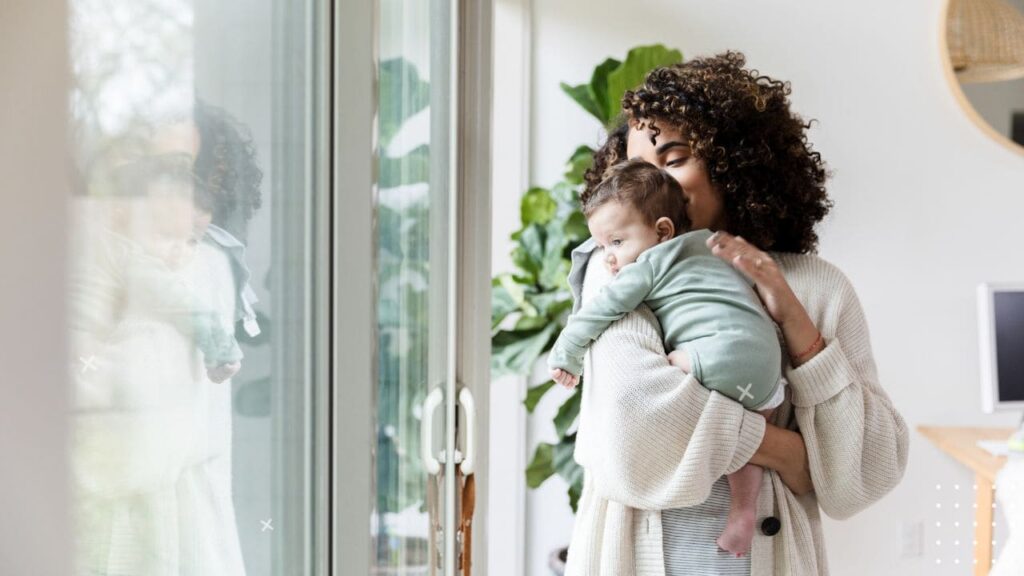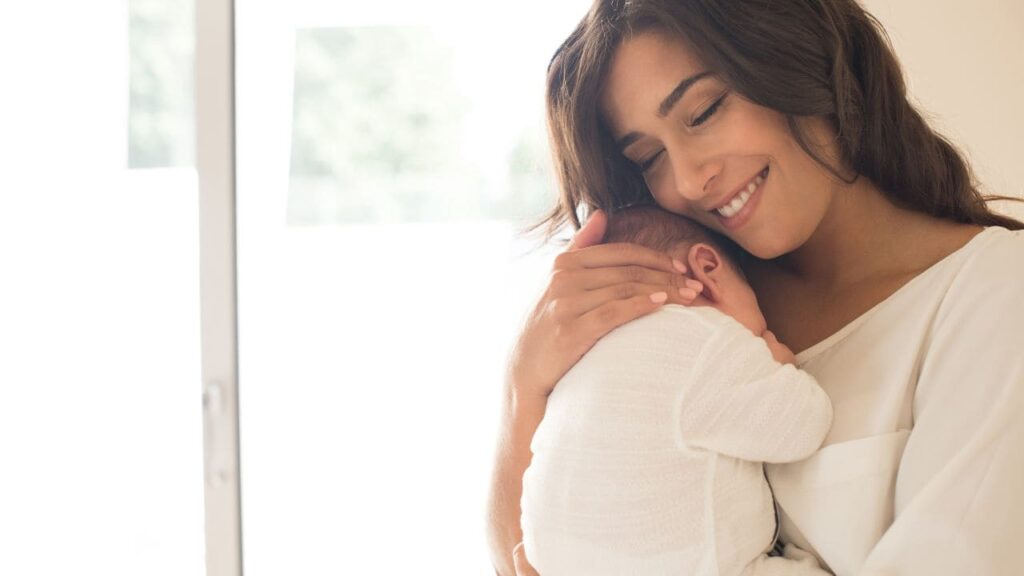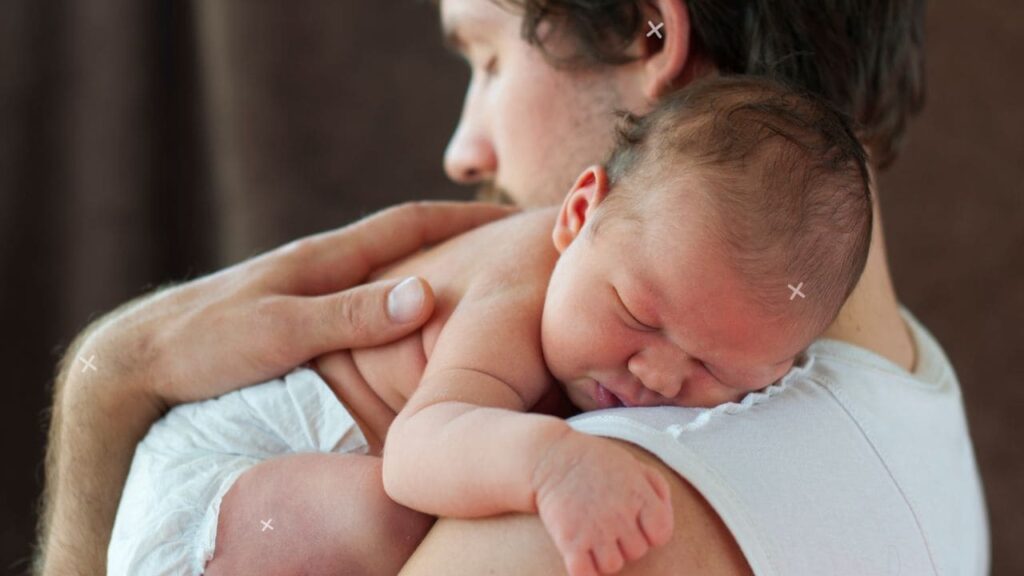As an exhausted new parent, I’ve uttered the phrase “my baby only sleeps when held” more times than I can count. If you find yourself in the same boat, take comfort knowing you’re not alone. Many babies under 6 months old drift off best with physical touch and support. But there comes a time when both baby and parents need to transition to independent sleeping.
The process can feel daunting, but have hope! With consistency, patience, and the right techniques you can help your little one learn to self-soothe and sleep soundly on their own. This ultimate guide covers everything you need to go from baby only sleeping when held to resting solo in their crib. Let’s dive in!
Why Babies Love Being Held Close
Before strategizing how to ditch the all-night baby-holding, it helps to understand why so many infants cling to it. Human touch offers nourishment on a primal level. A baby’s instincts drive them to seek the safety, warmth and care from caregivers that sustained them in the womb.
Plus, newborns spent 9+ months curled up tightly sans limbs flailing about. They thrive on feeling secure and enclosed. You replicating that nurturing “fourth trimester” environment tells baby their needs will continue being met.
As they develop, separation anxiety and stranger wariness also kick in. Your arms literally feel like home to your little one during their initial months earthside.
While snuggly babywearing sessions have their merits, issues arise when your babe only catches Zzzs while being held night and day. Let’s explore some common culprits behind this scenario and safe techniques to help baby sleep soundly solo.

Top Reasons Baby Only Sleeps When Held
If your infant instantly awakens the second you attempt to lay them down, a few key factors could be at play:
Falling Asleep While Feeding
Newborns often doze off contently when nursing or bottle feeding. But if they always conk out eating before placed in the crib, they miss learning to transition between sleep cycles on their own. Once your warmth and the food source disappears, it startles them awake.
Growing Too Dependent on Your Touch
Babies love being swaddled tightly or having their back gently rubbed. But if these comforting touches always precede sleep, baby becomes so reliant on physical sensations that they struggle drifting off without them.
Battling Reflux, Gas or Colic
Gastrointestinal discomfort like reflux or tummy trouble definitely makes infants fussier and interfere with quality slumber. Holding them upright can help ease symptoms so they sleep better. But you want to also treat the root cause and teach baby to self-soothe.
Dealing With Separation Anxiety
Between 4-8 months old, babies commonly go through a clingy phase where they burst into tears when mom or dad leaves the room. They might fight sleep knowing you’ll disappear. Gradually building their confidence and self-soothing skills helps them overcome this.
Missing Their Womb-Like Environment
Some babies, especially premies, seem to sleep best when tightly swaddled or snuggled. Why? Because it mimics the snugness of mom’s womb! You can recreate that security needed for quality Zzzs without actually having to hold baby all night.
Now that you know why your infant only catches zs in your arms, let’s cover the pros, cons and safety considerations of this scenario.
| Signs of Sleep Readiness | What it Means |
|---|---|
| Not always falling asleep nursing/feeding | Learning to transition between sleep cycles |
| Comforting themselves briefly before sleep | Early self-soothing skills developing |
| Napping solo during the day | Capacity to fall asleep without assistance |
| Sleeping partly through the night | Making progress with solo sleep |
| Growing more playful and interactive | Less sleep dependency on caregiver |
The Pros and Cons of Letting Baby Sleep When Held
I’d be lying if I claimed I never rocked my little one for naps as a newborn or snoozed with her resting on my chest. Sometimes you gotta do what you gotta do to get some sleep! But regularly bedsharing does come with certain tradeoffs.
The Perks
- Built-In Bonding Time
- Baby Feels Safe and Secure
- Less Disrupted Sleep Cycles
- Convenience Factor as Caregiver
The Pitfalls
- Safety Hazards (Suffocation Risks, SIDS concerns)
- Habit Forming
- Lack of Alone Time for Parents
- Sore Arms and No Free Hands!
- Difficulty Transitioning Later On
As you can see, it’s a double-edged sword. That’s why many pediatricians caution against making baby sleeping when held an everyday habit. The American Academy of Pediatrics advises against bedsharing for the first year especially.
That said, you know your little one and household dynamic best. I believe there are some occasions where nurturing baby to sleep in your arms does more good than harm, as long as safety precautions are taken.

Creating a Safe Sleep Environment for Baby
If you occasionally indulge in some sweet bedsharing cuddle time, prioritize safety:
- Firm Mattresses Only: No sagging couches or plush beds where baby could sink in and suffocate.
- No Loose Blankets or Pillows: These pose both SIDS risks and potential breathing hazards.
- Keep Baby Away From All Edge: Don’t snooze too close to the crib bars either where limbs could get stuck.
- Maintain Cool, Ventilated Room: Overheating raises SIDS risk so keep ambient temp between 68-72 degrees.
- Ensure Baby Sleeps Flat on Back: This reduces the chances of airway blockage. Avoid tummy time during sleep when SIDS risk peaks.
Remember, daytime napping in a baby carrier, rocker or your arms does enable bonding. But independent sleep remains crucial for development. Now let’s cover tactics to ditch the all-night baby-holding!
Signs Your Baby is Ready for Solo Sleep
While some infants give obvious cues about their readiness to sleep independently, others keep us guessing! Here are some telltale signs your little one may fare fine self-soothing:
- Not Always Falling Asleep Nursing/Feeding: Baby is learning to transition between active alertness to sleepy and back again. Promising!
- Comforting Themselves Briefly: You may notice them happily babbling, sucking their fist/thumb or clutching a lovey before dozing off. All show budding self-soothing skills.
- Napping Solo During the Day: Even 30-60 minute independent afternoon catnaps demonstrate capacity to fall asleep sans assistance.
- Sleeping Partly Through the Night: If baby already strings together 3-4 hour sleep chunks solo at night but needs help falling back asleep during wakings, that’s still decent progress!
- Growing More Playful and Interactive: Social smiles, coos and extra wiggliness demonstrating cognitive development. As baby becomes more outwardly focused, they need you a bit less during sleep.
If you’ve spotted some of these indicators, baby might tolerate a little solo crib time after some preparation. Even if not quite ready yet, implementing other sleep crutches first can help pave the way.

Helpful Sleep Tools Before Full Independence
Dropping the baby-holding habit cold turkey seems daunting. But various tools exist to help support quality sleep with less physical contact. Slowly utilizing these transitional tricks builds baby’s confidence to handle self-soothing:
The Magic Baby Swaddle
Recreating that cozy, womb-like containment babies love can work wonders. The key? Ensure hands stay loose near face so if baby startles, they can self-soothe by sucking their fist without busting out.
White Noise Machines
These provide consistent, soothing ambient sound that reminds baby of the white noise they heard inside mom’s belly. The predictability signals sleep time. Bonus points if you used the same white noise soundtrack in utero!
Baby Wearing Around the House
Wearing your baby in a front pack during daylight hours enables bonding while leaving your hands free. Then implementing an independent sleep routine at night gets them accustomed to sleeping sans carrier.
Loveys and Pacifiers
Introduce these around 3-6 weeks old. Having a special stuffed animal or blankie for baby to cuddle and pacifier to suck on mimics your physical soothing. Over time, these transitional objects help baby self-comfort when you’re not holding them.
Bedside Bassinets
Room-sharing eases the separation transition. Try a bassinet allowing baby to sleep independently but sensing your nearby presence. This fosters security needed to sleep solo.
The Gradual Retreat
Sit beside the crib, gently patting or shushing baby until they grow drowsy. Over successive nights, slowly move your touch further away. The goal? Baby falls asleep from you shushing across the room!
Be patient implementing these strategies. Consistency and commitment leads to success. Once baby shows signs of adequate skill development, it’s time to begin formal sleep training.

When to Attempt Sleep Training
While some pediatricians greenlight sleep training for infants as young as 4 months old, timing matters. Experts argue waiting until at least 6 months allows for greater neurologic development and self-regulation skills.
I recommend gauging your individual baby’s signs of being developmentally ready. A flexible sleep training approach also sets everyone up for success.
| Baby’s Age | Sleep Training Approach |
|---|---|
| 0-3 months | Swaddle, white noise, watch wake windows only |
| 4-6 months | Fading/camping method <10 min fussing |
| 6+ months | Gradual retreat, modest crying intervals |
| 9-12+ months | Extinction method with <15 min crying |
If under 6 months old, have modest expectations. Limit crying intervals to under 10 minutes before offering soothing reassurance. Only progress to longer windows if baby seems capable of eventually settling themselves.
The key is responding to your infant’s stamina, not rigidly sticking to a schedule. Trust your instincts!
Tips to Smooth the Sleep Training Transition
You’ve laid the groundwork helping baby self-soothe and noted signs suggesting sleep independence is within reach. Now it’s go time! Combining these best practices makes the break from bedsharing easier on everyone:
Pick a Gentle, Graduated Approach
From fading/camping out methods focused on subtle scaffolding to more cry-it-out extinction models, myriad sleep training philosophies exist. Know that hybrid approaches balancing care and encouragement of independence help most babies thrive. Customize as needed!
Equip the Crib
Ensure baby has access to sleep associations that bring comfort like a white noise machine, trusted blankie and pacifier. Feeling secure with cues signaling rest makes them less likely to panic when you’re not holding them.
Stick to Naps First
Mastering the independent naptime routine opens the door for solo nighttime sleep success. Once baby reliably falls asleep without physical touch for naps, bedtime feels less foreign.
Observe Optimal Wake Windows
Timing matters! Determine the ideal window between the start of baby’s last nap and bedtime based on age. Watch for tired signs like eye-rubbing and yawning signaling sleepiness peaked. Capitalize on that moment to initiate soothing bedtime rituals.
Offer Reassuring Check-Ins
If baby fusses or cries at bedtime, calmly return at predetermined intervals to reassure them with your voice and gentle touch. This prevents panic escalation while still encouraging self-settling.
Remain Patient and Consistent
Some babies adjust to solo sleeping within days, others take weeks. But sticking to the same soothing rituals and responses consistently instills trust and predictability. Be reliable and baby will catch on!
While the transition can feel bittersweet, remember this stepping stone is a huge developmental milestone! Now let’s tackle some common solo sleep training challenges.

Troubleshooting Tricky Solo Sleep Scenarios
Even after implementing sleep training, hiccups happen. From early morning waking to middle-of-the-night party sessions, baby can keep you on your toes! Here are some gentle troubleshooting tips:
The Early Bird Special
If your baby awakens too early raring to go, try subtly adjusting bedtime 15 minutes later each night to better sync with circadian rhythms. Also ensure the room stays dark with light-blocking curtains so early dawn doesn’t disrupt sleep cycles.
Nap Troubles
Master nighttime before naps. But if suddenly baby refuses solo daytime sleep, reinforce the same relaxing ritual used at bedtime. Keep lighting low, play soft music, sing lullabies. Remind baby their comfy crib signals rest.
Motrin Night Waking
For recurrent midnight waking past the six month sleep training mark, console baby lovingly but avoid removing them from the crib after a brief check-in. Providing more active soothing rewards the waking. Have confidence in baby’s self-soothing skills!
The Party Starter
If you find baby playing happily during night wakings versus crying for attention, experiment with dropping the check-in visit. Some babies treat midnight parent visits like play time! Quietly observe on the monitor until the party winds down.
The Soothing Song Request
Ah the classic scenario of baby dozing off independently initially only to call out for soothing songs/lullabies later on! Recorded music on a loop lets them self-activate this comfort. Or sing songs earlier in the bedtime routine to avoid associations.
While each baby has their own sleep obstacles, tailored troubleshooting helps overcome them. Just stay consistent addressing challenging scenarios kindly but without over-assisting.
Now that we’ve covered common struggles, let’s discuss what consistency actually looks like for bedtime routines.
Crafting a Soothing Sleep Routine
Guiding baby through the same series of pre-bedtime cues nightly sparks recognition that calming times ahead. Over time they intuitively prepare for sleep. Aim for your ritual to span 30-60 minutes.
Sample Bedtime Routine
- 6:00pm: Bath using lavender bath wash. Kickstarts relaxation and signals cleansing before bed.
- 6:20pm: Massage with soothing lotion or baby oil to loosen muscles
- 6:40pm: Nurse or bottle feed while playing soft music
- 7:00pm: Read sleep-themed books in dim lighting
- 7:15pm: White noise on, sleep sack or swaddle, pacifier offering, hugs and kisses with “I love yous.”
- 7:20pm: Place drowsy baby in crib semi-awake. Say goodnight confidently even if tears emerge.
- 7:30pm: If no solo sleep after 10 minutes, brief loving check-in with pacifier reoffering and shush-patting. Repeat 2-3 times spacing check-ins out before commitment to self-soothing likely.
Customize it to your timeframe but keep each element consistent, even on weekends. Routines boost babies’ sleep cooperation!
Soon baby associates this routine with feeling ready for bed and relaxed enough to drift off solo!
Takeaways: Transitioning Your Baby From Only Sleeping When Held to Independent Sleep
The key ingredients helping babies successfully shift from only sleeping when held to peaceful solo sleep include:
- Understanding why infants initially seem dependent on physical touch to drift off
- Determining your baby’s stage of self-soothing developmental readiness
- Trying sleep tools like swaddling and white noise to help compensate for losing physical touch
- Noting signs baby can likely start sleep training with graduated check-in methods
- Sticking to lovingly implemented, age-appropriate sleep training techniques
- Troubleshooting bumps in the road consistently but without over-assisting
- Building an enjoyable, ritualized bedtime routine signaling rest
While the path feels bittersweet, remember that independent sleep remains a pivotal foundation for baby’s growth. Stay the course utilizing compassionate sleep training strategies aligned with your infant’s needs.
Trust in their budding resilience. Before you know it, your little one will drift off confidently without your touch when the time is right! Both of you have got this.
FAQ – Baby Only Sleeps When Held
Does bedsharing increase my baby’s risk for SIDS?
Yes, bedsharing or sleeping with your baby in an adult bed increases the risk of sudden infant death syndrome (SIDS). According to the American Academy of Pediatrics (AAP), SIDS risk factors include soft bedding, blankets, pillows and other clutter in the shared sleeping environment. The AAP recommends room-sharing for 6-12 months instead.
My newborn only falls asleep while nursing. What should I do?
Letting your baby only fall asleep while nursing reinforces sleep associations that make it difficult for them transition when you’re not there. Try nursing earlier, ending the feeding once baby is drowsy but still awake. Then transfer them to the crib so they can learn how to drift off independently too.
I’m desperate for sleep. Could rocking my baby all night be OK temporarily?
We understand the desperation for sleep in those early days! Occasionally doing what you need to survive is alright. But regularly rocking or holding your baby all night long can become an unsustainable sleep crutch that has negative consequences over time. Try gradual weaning instead.
How many times should I let my baby fuss before intervening at bedtime?
There’s no set magic number for how long to let baby fuss before responding while sleep training. At under 6 months old, limit intervals to under 10 minutes offering soothing comfort. Over 6 months old, longer intervals may prepare them for self-settling. Follow your instincts responding to your baby’s developmental needs!
My first two kids were easy sleepers. Why won’t my third baby sleep unless held?
Don’t compare babies! Each child’s sleep needs and self-soothing capabilities differ. Stay consistent with your independent sleep strategies tailored to this baby’s temperament. Sleep challenges often mysteriously resolve around 4-5 months old as melatonin production kicks into gear. Have patience!












